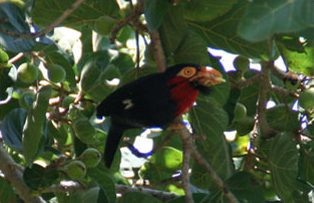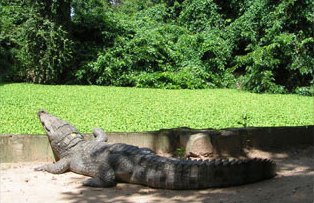

Abuko Nature Reserve is one of the oldest established reserves in the Gambia. An evergreen forest gallery follows the course of the Lamin Stream and covers approximately 1/3 of the reserve area. Efforts are being concentrated on maintaining the winding bush trails, bird photo hides and animal orphanage as well as the boundary, to prevent encroachment by people and cattle. There are three small pools in the reserve, the biggest being the Bamboo Pool. This freshwater pond and its vicinity are a great location to spot crocodiles and birds. Abuko is within easy reach by taxi from any of the main coastal holiday resorts. It is an ideal first stop for birdwatchers, animal enthusiasts and tourists in general. There are designated guides on site to help you find animals and birds while on the forest trail – a tip is always appreciated though not mandatory! Abuko’s area was extended from 188 to 259 acres in 1978 and, with the help of the WWF, the reserve was enclosed in a 2.5 meter fence. It is one of six protected wildlife management parks in Gambia and covers an area of 105 hectares (roughly 2 sq.km).

Bijilo Forest Park is a small rainforest nature reserve located on a cliff edge on the beach and within easy walking distance of the Senegambia strip. It is an ideal place for eco-tourists & birdwatchers staying in the nearby Kairaba & Senegambia hotels. Bijilo Forest is host to over 130 species of birds such as the Red-necked Falcon, Grey Hornbill, Senegal Coucal and various Bee eaters There are also 4 primate species, the Patas monkey, Green Vervet monkeys, Red Colobus and the Galago or Bush baby that inhabit the park. Please take notice of the signs asking visitors not to feed the monkeys – as this will interfere with their natural behavior and re-duce their fear of humans, putting them in danger of being harmed or stolen. Among the flora are lilies, wild orchids, salt-tolerant vines, magnificent silk cotton trees, palms and the odd-looking baobab tree (sometimes called the upside-down tree).
Lamin Lodge is situated on the edge of the creeks; this huge tree house style lodge offers a wonderful view over the mangrove swamps and is an ideal spot for bird watching. Small boats can also be hired from here.
Makasutu Culture Forest Makasutu is a Mandinka word meaning “Holy Forest”. The owners of this beautiful resort began a venture that would, after almost fifteen years, earn them a reputation as having The Best New Eco Lodge in The World, according to the Sunday Times in 2002. Further awards were bestowed on the serene lodge with the awarding of the prestigious “Guild of British Travel Writers Award” in 2004, and Winner, Eco Tourism Award 2005. Makasutu offers day trips with guided walks through the forest and trips along the creeks in dugout canoes offering a good opportunity for bird watching and wild animal observation. There is a craft area where local artists show their talents and skills in woodcarving, design ware and other traditional African artifacts. A traditional lunch with cultural entertainment is put on to round up the day.
For those who wish to stay longer Madinara Lodge offers eco-friendly accommodation of the highest standard. Feel at one with nature, wake up to the call of the birds and spend time in their natural habitat. It is one of the few places in the world that the Manatee (known as the sea cow) lives in the shallow waters edge and they have been known to give birth under the floating lodges. This rare experience is only possible to encounter by staying at the Madinara lodge.
Baobolong Wetland Reserve is located on the northern bank of the Gambia River in central Gambia, opposite Kiang West. This wetland covers 22,000 hectares and was designated as Gambia’s first RAMSAR site (a wetland of international importance).
Kiang West National Park is located on the southern bank of the Gambia River in central Gambia. Its 11,000 hectares are dominated by dry woodland vegetation, with areas of mangrove and mud flats.
River Gambia National Park is more commonly known as Baboon Islands. It is a 580 hectare park covering five mid-river islands near Georgetown in eastern Gambia. It was established mainly as a rehabilitation sanctuary for chimpanzees. Visitors are not permitted on the island.
Niumi National Park in the northwest of Gambia is contiguous with the Parc National du Delta du Saloum in neighboring Senegal and incorporates the coastal island of Ginak. It covers 5,000 hectares and features dry woodland, sand dunes, mangroves, salt marches and lagoons.
TANJI River BIRD RESERVE is located on the coast, in western Gambia. Its 612 hectares include dunes, la-goons, mangroves, dry woodland and is popular for the variety of birds which can be seen in and around the reserve.